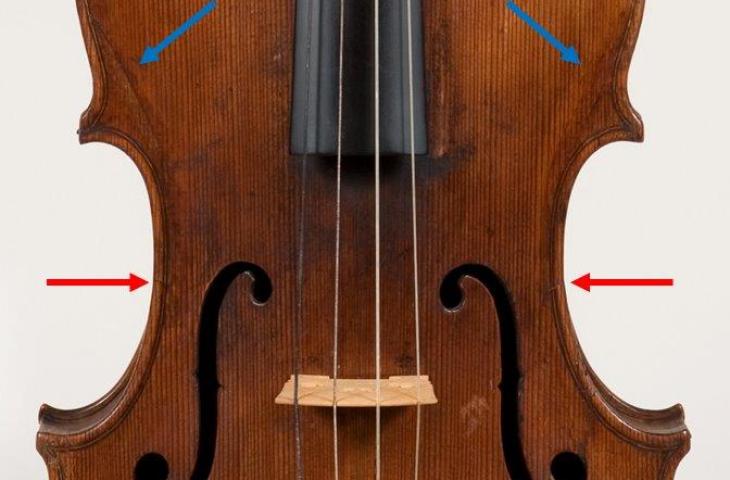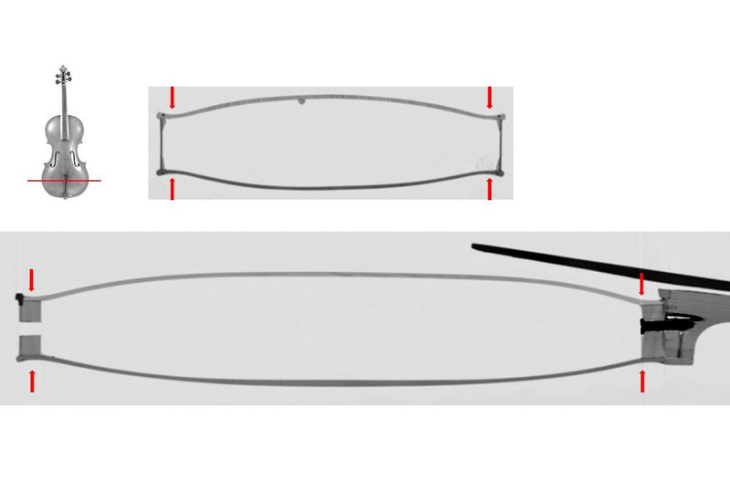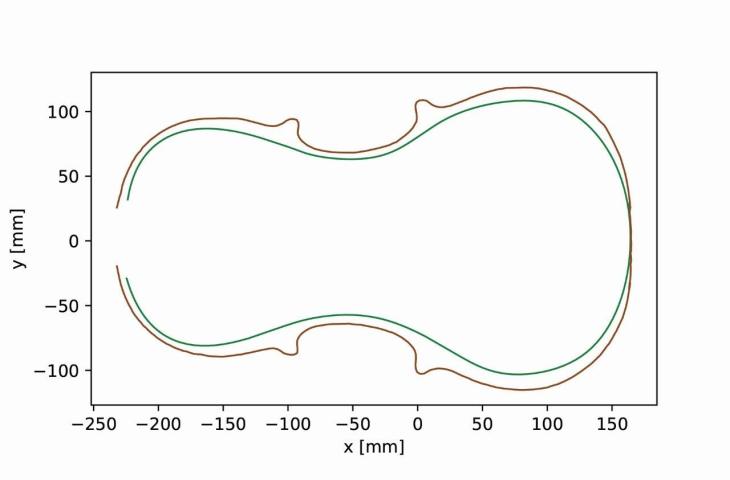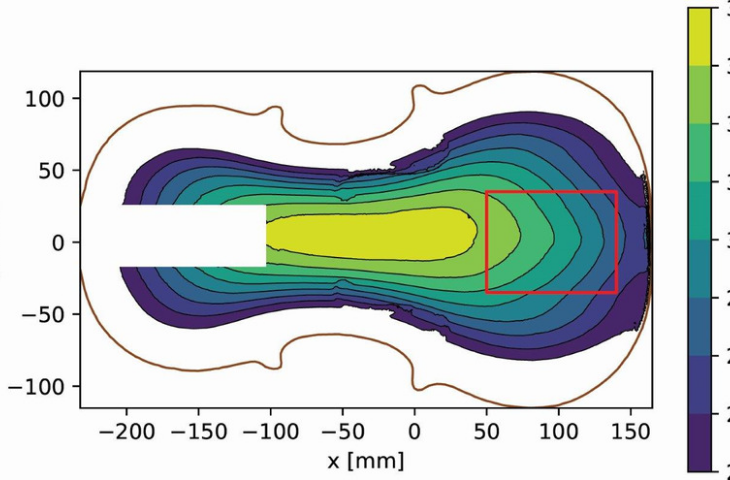June 2023
Fig.1

Viola, Matthijs Hofmans, Antwerp, before 1679, inv. 2846
Fig.2

Methods of reducing a soundbox. Left: Reduction in height; Right: Reduction in width
Fig.3

Reduction of the size of the C-bouts, inv. 2846
Fig.4

Viola, Johannes Cuypers, The Hague, 1761, inv. 2833
Fig.5

Transverse and sagittal view of the viola by Matthijs Hofmans, inv. 2846
Fig.6

Transverse and sagittal view of the viola by Matthijs Hofmans , inv. 2846
Fig.7a

Tracing of the channel on the soundboard of the viola by Johannes Cuypers
Fig.7b

Tracing of the channel on the soundboard of the viola by Matthijs Hofmans
Fig.8

eoretical effect of the reduction in width of the body on the contour lines
Fig.9a

Rounded contour lines on the soundboard of the viola by Johannes Cuypers
Fig.9b

Angular contour lines on the soundboard of the viola by Matthijs Hofmans
Evolution of the violin family
Since the mid-eighteenth century, the violin family has consisted of three clearly differentiated instruments: the violin proper, the viola, and the cello. (The well-known double bass actually combines morphological characteristics of both the violin and the viola da gamba.) During the Baroque period, however, the violin family was much more diverse in size. It was only in the first half of the eighteenth century that the quartet - composed of two violins, a viola and a cello - gradually became established in both chamber music and orchestral repertoire.
Structural Alterations of Baroque Instruments
As a result, many older instruments fell into disuse. Their dimensions did not correspond to the new standard of the quartet, and their short, thick necks were not suited to the increasing virtuosity expected of musicians. To give these outdated sound objects a second life, luthiers fitted them with new necks and sometimes reduced the size of the soundbox.
While the replacement of the neck is a well-documented practice, the modification of the soundbox is less familiar. Early sources describe two methods: to shorten the instrument, a crescent-shaped section of wood was cut away at the top and bottom of the body; to narrow it, a strip of wood was removed along the axis of symmetry (fig.2). Both methods could be combined and adapted as needed.
This is what happened to an instrument made by the Antwerp luthier Matthijs Hofmans (1622–1672), now preserved in the Musical Instruments Museum as a "viola" (inv. no. 2846). This instrument received a new neck, and both the height and the width of its body were reduced—probably in the late eighteenth or during the nineteenth century. The alteration can be deduced from the presence of wooden inserts placed near the upper corners of the soundboard and back (blue arrows in fig.3).
Originally, the C-bouts were clearly larger, in proportion to a longer soundbox. In order to adapt the size of the C-bouts to the reduced body, they were incised halfway down (red arrows). The luthier carefully cut the edge and the purfling up to the corners. After inserting the wood strips, he glued the corners and edges back to the top and bottom plates.
Visual Analysis of the Modifications
To assess the modifications made to the Hofmans viola, several geometric irregularities were analysed. A later, unaltered viola by Johannes Cuypers (MIM, inv. no. 2833) served as a point of comparison (fig.4).
To detect a reduction in length, one should examine the channel that runs along the edge of the arching on both the back and soundboard. In a shortened instrument, this channel tends to disappear at the top and bottom of the body, whereas on a normal instrument, it remains more or less parallel to the edge throughout. Figures 5 and 6, obtained via CT scan, are revealing: figure 5 shows the channel in both transverse and sagittal sections of the Cuypers viola (red arrows), while figure 6 shows the channel only in the sagittal section of the Hofmans viola—not in the transverse one. This indicates a reduction in length.
Using 3D models obtained through photogrammetry, the channel on the soundboard of both instruments was mapped (fig.7). On the Hofmans instrument, the channel merges with the edge of the body at both ends.
To determine whether the body was also narrowed, the contour lines offer a good clue. On a normal instrument, these curves are rounded. However, when a strip of wood has been removed along the central axis, the curves are expected to be more angular, as suggested in figure 8.
In practice, archings are rarely symmetrical, especially on older instruments whose wood has warped over time. Nevertheless, angular curves can clearly be seen on the Hofmans viola, as shown in figure 9. This instrument has evidently been reduced in both height and width.
Musical consequences of the alterations
These modifications have significant musical implications. Since many surviving Baroque violins, violas and cellos have been altered, they cannot be considered faithful witnesses of the period in which they were built. Their timbre has changed and now aligns more with the sound ideals of the late eighteenth and nineteenth centuries than with those of the seventeenth. For historically informed performance, it is crucial to take this into account and to approach the repertoire of the period with awareness of the great morphological diversity that once characterised bowed instruments.
Bibliography
- Anne-Emmanuelle Ceulemans, Philémon Beghin, François Glineur, Paul Fisette, Iona Thys, « Baroque Violas with Reduced Soundboxes: An Evaluation Method » The Galpin Society Journal, LXXVI (2023), p. 109-126, https://www.galpinsociety.org/open%20access.htm
- Philémon Beghin, Anne-Emmanuelle Ceulemans, Paul Fisette, François Glineur, « Validation of a photogrammetric approach for the objective study of ancient bowed instruments », https://arxiv.org/abs/2205.08745v2, submitted to Heritage Science.